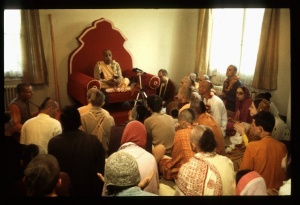SB 2.2.26

A.C. Bhaktivedanta Swami Prabhupada
TEXT 26
- atho anantasya mukhānalena
- dandahyamānaṁ sa nirīkṣya viśvam
- niryāti siddheśvara-yuṣṭa-dhiṣṇyaṁ
- yad dvai-parārdhyaṁ tad u pārameṣṭhyam
SYNONYMS
atho — thereupon; anantasya — of Ananta, the resting incarnation of Godhead; mukha-analena — by the fire emanating from His mouth; dandahyamānam — burning to ashes; saḥ — he; nirīkṣya — by seeing this; viśvam — the universe; niryāti — goes out; siddheśvara-yuṣṭa-dhiṣṇyam — airplanes used by the great purified souls; yat — the place; dvai-parārdhyam — 15,480,000,000,000 solar years; tat — that; u — the exalted; pārameṣṭhyam — Satyaloka, where Brahmā resides.
TRANSLATION
At the time of the final devastation of the complete universe [the end of the duration of Brahmā's life], a flame of fire emanates from the mouth of Ananta [from the bottom of the universe]. The yogī sees all the planets of the universe burning to ashes, and thus he leaves for Satyaloka by airplanes used by the great purified souls. The duration of life in Satyaloka is calculated to be 15,480,000,000,000 years.
PURPORT
It is indicated herein that the residents of Maharloka, where the purified living entities or demigods possess a duration of life calculated to be 4,300,000,000 solar years, have airships by which they reach Satyaloka, the topmost planet of the universe. In other words, the Śrīmad-Bhāgavatam gives us many clues about other planets far, far away from us which modern planes and spacecraft cannot reach, even by imaginary speeds. The statements of Śrīmad-Bhāgavatam are accepted by great ācāryas like Śrīdhara Svāmī, Rāmānujācārya and Vallabhācārya. Lord Śrī Caitanya Mahāprabhu specifically accepts Śrīmad-Bhāgavatam as the spotless Vedic authority, and as such no sane man can ignore the statements of Śrīmad-Bhāgavatam when it is spoken by the self-realized soul Śrīla Śukadeva Gosvāmī, who follows in the footsteps of his great father, Śrīla Vyāsadeva, the compiler of all Vedic literatures. In the creation of the Lord there are many wonderful things we can see with our own eyes every day and night, but we are unable to reach them equipped by modern materialistic science. We should not, therefore, depend on the fragmentary authority of materialistic science for knowing things beyond the range of scientific purview. For a common man, both modern science and Vedic wisdom are simply to be accepted because none of the statements either of modern science or of Vedic literature can be verified by him. The alternative for a common man is to believe either of them or both of them. The Vedic way of understanding, however, is more authentic because it has been accepted by the ācāryas, who are not only faithful and learned men, but are also liberated souls without any of the flaws of conditioned souls. The modern scientists, however, are conditioned souls liable to so many errors and mistakes; therefore the safe side is to accept the authentic version of Vedic literatures, like Śrīmad-Bhāgavatam, which is accepted unanimously by the great ācāryas.